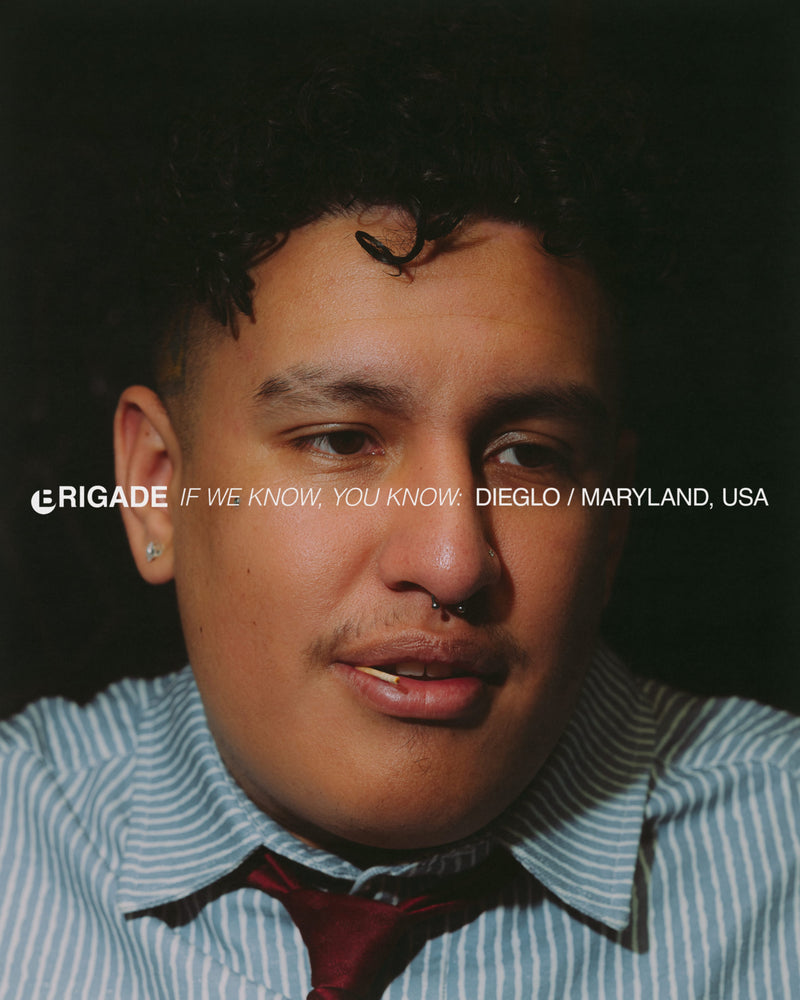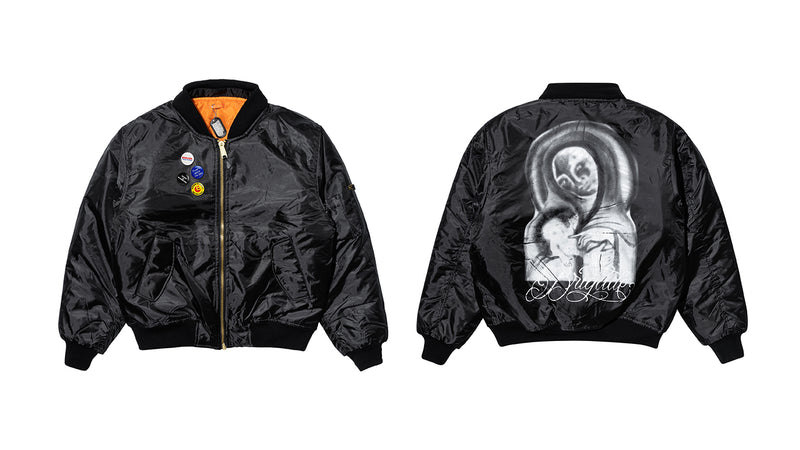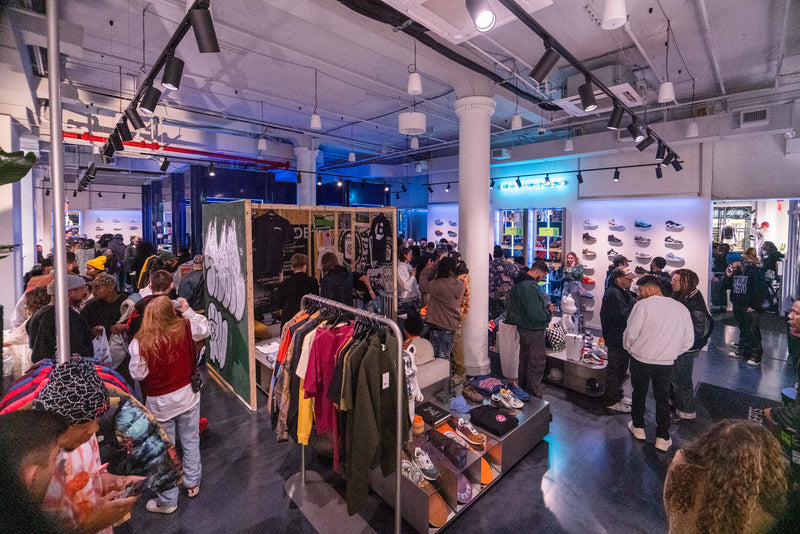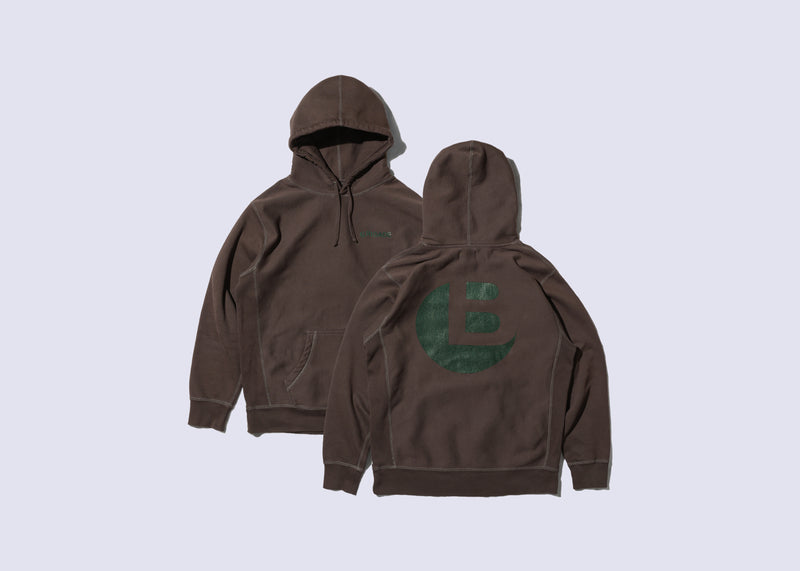
“Every Man Has Two Lives..”
Diego mentioned on the rainy drive to his latest art show, “Still Unemployed." We met Diego in Tokyo this past November, while on a spontaneous trip with NYC graffiti bombers, SKAM and RUT. The first night in Tokyo, SKAM mentioned a friend of RUT’s would be joining us for dinner, and although neither of us knew Diego, but by way of our friends we knew he would be solid. From the moment he stepped into the dining room, where we sat legs crossed and with no shoes on, he had an aura. It was like meeting an old friend, where the conversation flows seamlessly. After spending a week together in Tokyo, we made plans to stay in touch when we got back to our respective homes, NYC and the DMV. As soon as Diego announced his show, we booked our trip to DC…

Born and raised in Rockville, Maryland, Diego carries with him a rich cultural heritage, with his mother hailing from Chile and his father from Peru. His parents' story of meeting in the United States, against the backdrop of their respective journeys as immigrants, lays the foundation for Diego's own narrative — a narrative deeply rooted in family, resilience, and the pursuit of creativity. Despite being an only child, Diego's chosen family and his upbringing in a close-knit community have played a significant role in shaping his worldview and his artistic endeavors.

Diego's path to becoming an artist was neither straightforward nor conventional. Throughout his schooling, he doodled on any surface available from scantron sheets to homework, a practice that was more about self-expression than about seeking a future in art. Despite the lack of encouragement from the educational system, which often failed to recognize his talent even in art class, Diego's doodles persisted. It was only after high school, amidst a period of self-discovery, that he seriously considered pursuing art as a career and enrolled in a graphic design college course. It didn’t take more than a week for Diego to realize this path would not satisfy him long term, and he dropped out to pursue his art in a larger way. Already known in the DMV art community from being an active participant in the scene, Diego started sharing his work. First, on paper then building to smaller format canvases and eventually large murals around the city. His journey is a testament to the power of trusting your inner compass, even when the path is unclear.
Diego's art is deeply personal, mirroring his subconscious while also being inspired by his affinity for scary thematics, which grew from his love of Halloween being an October baby. Diego expanded “In a time I did have a lot of darker thoughts, but now it's just reflective, you know, my sharp teeth in my drawings doesn't mean, oh, it's a monster that's going to eat you. It's more like, damn bro, like you really got to clean yourself up.” Diego's almost year long journey with sobriety has also profoundly impacted his art, bringing a new depth and clarity to his work. In his most recent gallery exhibition, Still Unemployed, Diego noted the transition point to sobriety created a noticeable difference in his artwork saying, “I learned a lot about myself. I learned a lot about who I surrounded myself with.”

-
How did you find your style? Do you think you are still discovering it?
-
I used to only draw with pencil. And then I realized that I was stuck on the same painting and I would have to remind myself, there's more canvases at the store. So if I’d fuck something up, I'd paint it white all over, or I would punch a hole and throw it away. I was so hard on myself that I realized, leave your mistakes on it and then fix them later. So eventually I came up with the style like how if you tear a garment, you can sew it back up together. So it'd be like stitching. The speech bubble (behind him on the wall) for instance; realistically, I fucked up the first circle, the original one. So I added a second one, and the second one was the correct one so I stitched them together. All my work that you see, whenever it has stitching on it, it's my way of leaving my mistake on the piece. In a way it still has that originality, but I did it so my brain just felt better, and it wouldn't feel unfinished. But in reality, it was something that aesthetically created a style. Now whenever I do a mural, I don't have to put my name, it just comes back to me. Now because I got sober and take more time with each piece, I started doing the swirls because that's the actual motion of stitching up, rather than a quick stitch.

-
-
What is the inspiration behind Still Unemployed?
-
Still Unemployed was something I always thought about because people always ask me, “what do you do for work?” And when I say, “oh, I'm an artist.” They're like, “No, what do you do as a job?” And I'm like, “I'm an artist.” I don't get insulted, but I understand where they're coming from. In a way, this [Still Unemployed] is like, a juxtaposition of words -- of what people expected of me. We put the gallery together and that this is my way of telling everybody I'm “still unemployed”, I still don't have a job, I'm still just an artist. In the short video we made to promote the event, it's me waiting on some job interviews. Everybody that made the calls were just my friends pretending to inform me that my application's been denied. It’s funny because I don't plan on being “employed”

-
-
What do you consider your biggest accomplishment?
-
I think I get new accomplishments all the time, but one of my top accomplishments that I've done is I was going to get picked up by Nike ID at one point. They were going to have a branch where they were going to design t-shirts, and they got 50 artists from all over the US to design a shirt about persistence, and each design was going to get printed, we each had a code, and it was going to go on the Nike website. Then March 16th happened, and everything got shut down because of COVID. They sent me a $500 gift card, but this is probably one of the only things that I actually cried about. In my head, I was like, "Bro, Nike knows I exist." Me and all 50 other artists were cut. I still have my design in my journal to this day, but yeah.
-
-
What is the strangest place your art has taken you?
-
A cemetery - I painted a coffin one time. Basically, I work with this group called Dia de los Muertos. They do a little bit of a lot, but they are a non-profit that throws these events and fundraisers that tries to help immigrants, supports Black Lives Matter, and they like to help people of color and minorities in general through the creative community. For one of their events, they rented out a cemetery for the Day of the Dead and they had live dancers, and then they had me live painting. I had painted a coffin, like a wooden coffin, and everyone was drawing cool little things around it. I drew like a dead character and shit, bro and next to me there was people drawing like flowers and like sugar skulls. That’s probably to this day, the weirdest place my art, or the most interesting place my art, has taken me. I could have never expected that.
-
-
What advice would you give to your younger self?
-
None. No advice. Everything that I experienced, everything that I did, everything that happened to me, it built this character, you know? It created this. It's not like nothing happened for an accident. Nothing happened for no reason. There were things that happened and, you know, I'm like 10 months has passed but I'm still waiting for that reaction, but I've learned from every single second I've been alive.

-
-
What advice would you give a young artist?
-
You got to paint every single day. You got to do it through thick and thin. You got to eat cup noodles and eggs and rice for months and just be okay with it. You have to be disciplined at the end of the day. You have to, have a little bit of delusion and narcissism, like mixed together. That's honestly what it is. I'll be honest with you, a lot of people that I started doing this with were other creatives, they did clothes and art and rap and music and instruments. Some of them like would go through hurdles and shit in life, bad things happened. They were at their breaking points. For me, I survived COVID as a full-time artist. You have to really have that be your only plan, and it's going to work. I'm talking about if I told 18 year old me, “yo, you got 700 RSVPs”, I'd be like, “fuck no, bro.” Getting 30 people together at one point, it was just, it was insane. That's how this whole route goes.

-
-
Where do you find inspiration?
-
It’s the randomest things. I went to the thrift store the other day and I saw this cool little frog with a hat on, but the way his leg was, it looked really weird and unproportioned. In my journal I wrote that I want to draw this character with kind of unproportional frog legs, but it's a short stubby human. My imagination finds inspiration while I'm wandering in the world. Media also inspires me. My favorite movies include Spirited Away, which I think that's the most cliché, anything Studio Ghibli really, Step Brothers, and Nacho Libre (I’ve watched that a thousand and three times). Music really inspires me. Some of my favorite artists are Kodak Black, Frank Ocean, John Coltrane, Kendrick Lamar, Kanye West, and Spanish music in general. I really like Peruvian music, it is just a good vibe. It's like real mountain people music. [Opens Spotify on phone] So, this one's, this song is called Cerveza Cerveza. This is what my grandma used to listen to.
-
-
What is a place that has impacted you personally?
-
Definitely Peru. My dad lives out there, and I got to reconnect with him. I saw where my father came from, and where my bloodline comes from. Anytime I talk about Peru, it's just-- I don't know how to put it into words, but it was just like I could be as crazy as I wanted to be. It's nothing I'm used to, you know? They have this saying where it's just like people from that country leave and then come back and think they're hot shit. And it's like me coming, you know, from a good life, you know, what a single mom, that's the most I had to deal with? Like we still had a pretty good life, I could say. Going over there, people were like, "Why are you so sweet? Why are you so kind?" I did a lot of my art there because a lot of the materials are cheap. Production is cheap, and they have these giant factories all over the place where you can do anything, just whatever you can think of, they have. I wanted to make a poster and when I went to go see the poster sizes, one of the sizes was like 104 by like 90, so I made a ginormous 104 by like 90 poster for 25 bucks. It was one thing for me to have that piece, and then for me to just be able to make it huge, it was awesome. I left it there, it's still in Peru. The collection that's at the gallery, there's four pieces missing and all four of those pieces are in Peru, and they're the biggest ones. Peru, everything; the people, the food, the scenery, even experiencing the different social classes. You can go up the street and there's nice houses, but we live on dirt roads. It's kind of fucked, but still, it was such a beautiful experience. And on top of that, I'm building a relationship with my dad and listening to who he is as a human being on this earth. We're two completely different people, but for the most part, my family over there supports what I do.

-
-
What was the tipping point for your sobriety journey?
-
My first trip to Japan. The first time I went to Japan I had gotten really fucked up, to the point where there's videos of me sleeping on the street. I did that here, but seeing it happen out there made me think about how I've always dreamed about going to Japan. Like 13, 14 year old me would be like, “what the fuck bro? why am I fucking it up so bad?” Then eventually I got in trouble. I almost got arrested. My best friend was there luckily and he had to pay the club $1,000 American dollars for them not to file a report on me, but I was detained already by the police officers. They were talking to me in Japanese and I was translating on my phone. It was just fucked, and it was just like all because I wanted to get piss drunk and do some stupid shit. Within sobriety, I also realized I was unorganized. I'd write a sticky note, put it in my wallet and then never open it again. Now I have like a whole journal where I write my everyday thoughts and what I need to do every day. I'm doing things that I should have been doing when I was younger, but I'm catching up. I feel like I wasted so many years, but regardless, the sobriety was a very big impact on my art. You know, it needed to happen and better sooner than later because some people just crash out.

-
-
What are some long-term goals you are aspiring towards?
-
Becoming a creative director of a brand -- I don't know what brand yet. I want to be a creative director for a brand because a lot of the ideas I have right now, they're all very big budget, but I’m focusing on making my own bag as a painter. Don't get me wrong, I feel like my timeline, is to make consistent money with the art and then eventually start to venture into creative directing. There's a lot of cool ideas I have but a lot of these projects are outlandish so it's hard for me to portray them and show people. Eventually I do want to make things that haven't been made before, or make it in my own style. For example, I get a high even when I make a clay sculpture, and clay sculptures have been made a thousand times, but not my clay sculpture.
-
As he continues to evolve as an artist, Diego remains committed to exploring new ideas and pushing the boundaries of his creativity. His story of the relentless pursuit of one’s dreams contains many “firsts” for his lineage, from traveling the world to receiving over 700 RSVPs for his latest gallery. His resilience, passion, and transformation embody the saying “every man has two lives, and the second one starts when he realizes he has just one.”





0 comments